An Evening at the Keelung
One of my basic regrets is not keeping a journal during our trip to Taiwan at the turn of the millennium. It was my lost journey, ‘riding the dragon’s tail’ as a young soldier put it when we shared a smoke at the back of a train.
I was culture-shocked and goggle-eyed throughout as I soaked in hot springs at the bottom of a marble gorge, had tea with Buddhist nuns who submerged themselves fully clothed (even their feet were wrapped), danced underneath a pagoda with a boy who’d given me a ride but wouldn’t let go until we had done that, hitched lifts on the backs of over-balanced scooters without meaning to and then hung on for dear life as we narrowly evaded jagging rocks in roughly-hewn tunnels, chewed betelnut only to find that the Oolong tea I sampled in Alishan got me higher, looked up 60m tall trees before lunching on lotus root soup in a plum grove, felt the Earth move eight storeys up and again on the way to the night market in Tainan, closed my eyes as six lanes of scooters faced me cycling down a major road when the traffic lights turn green to signal the start of the Kaohsiung rush-hour Grand Prix…
…and sampled the food. Oh yes, the food.
We (John was visiting the university while I did all that) took part in not one, but two banquets. The elaborate menus promised a series of delights in twelve dishes or more (some of those dishes were sets), all in Chinese. The choicest seafood, the richest stews. Items that I’m sure our friends had mis-translated (beef tendon?). And yes, I admit it, sharkfin soup and birdsnest soup for Christmas. The latter is nothing to write home about, but the former… Not worth the overfishing of sharks to be sure. Or sea cucumbers for that matter.
But Chinese, all in Chinese. I cannot recall, cannot translate, and stupid me took no notes. The flavours and textures seemed forever lost; occasionally reflected in Mandarin and Cantonese menus, the ones that are never translated into English. Strictly under-the-counter eating, and never quite the same.
Until I walked past a place on Lisle Street that calls itself Keelung (Seafood Market) Taiwanese Restaurant and images of night markets and temple yard eateries came to mind. Sizzling oyster omelets. Scorching stinky tofu, cooked Szechuan style with the heat mercifully blasting away the smell (John liked it). Goosenecks on sticks. Cheap but tasty bowls of rice and mince. A woman wrapped up in a warm coat serving us shaved ice which we’d mistaken for something warm (relying on pure pattern recognition here). Maxi-sized steamers stacked up in leaning towers. Trays of glistening seafood arranged in grids, some of it still alive. More seafood swimming, crawling or gliding in rows upon rows of orange plastic crates, and which I never got to sample as it’s famously pricy.
All that here for the picking?
Well, not quite. Which is just as well.
I thought the portions would be small. Just a mouthful. This is London, and the place even calls itself a tapas restaurant on its website (though not on its business card). Surely I could go with two starters (dumplings for sharing), a fish dish and steamed vegetables flavoured with a bit of ‘grounded pork’, like I remember from Taiwan where most vegetable dishes are mixed with bits of meat. I’d still have plenty of room to sample what the others order.
“No rice?” The waitress asked. “you should order some rice.”
They wouldn’t serve us a big bowl of plain rice for sharing, so I added pork belly steamed rice to the list.
The others were more restrained, except perhaps for John who went for a ground(ed) pork rice bowl he had so enjoyed around that backstreet temple in Kaoshiung when the food stalls opened in the evening, Szechuan-style gray clams since we wanted to sample a bit of seafood and pig kidney in sesame oil and rice wine. The others had only two dishes each.
So how come the table was so packed that the food had to be served in stages?
Here’s what we ate:
There’s not much Dim sum in my life, so I couldn’t resist the Keelung Siu Loung Bao special, wheat-wrapped dumplings that burst in the mouth with meaty goodness, complemented by A’s order of delicate rice-pastry with chicken and mixed vegetables with crunchy peanut. They arrived with a soy and rice vinegar dip flavoured with ginger matchsticks that took me right back.

(My way has always been to dip the things in the sauce and cram them into my mouth, but later reading revealed that the stock-filled xiao long bao are best not tackled that way. Lift them onto the soup spoon and devour them piecemeal, catching the liquid on the spoon.)
I had high hopes for the ground(ed) pork which I remember with a touch of chili oil smokiness and earthy spices, mixed sparingly in with the rice. Here it was more of a brown-grey sludge, flecked with gristle and too much liver. If the liver had been more restrained, it might still have passed.

A nice note for the steamed choi-sum was the banana leaf lining the basket, which made a subtle, but noticeable, difference.
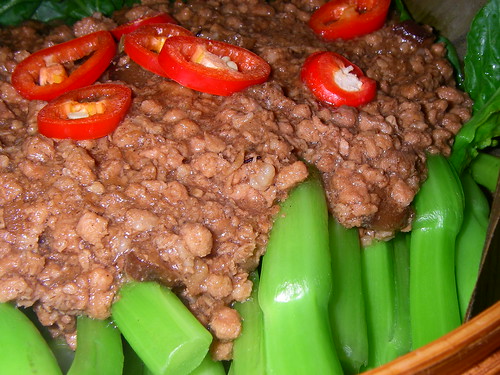
The choi-sum (also featured as ‘Chinese broccoli’) was delicious and more successful when served in its own right: stir-fried with plenty of garlic. A thick, green, juicy vegetable—if a bit fibrous—and a necessary counterpart to all the rich food.
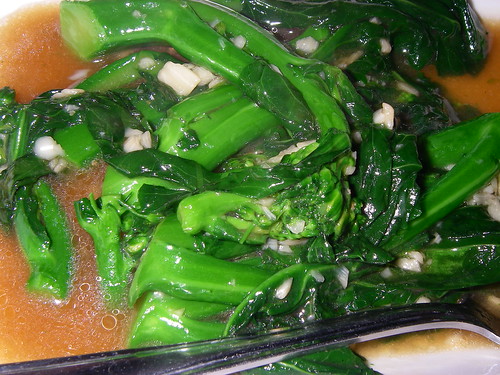
My own ‘rice’ was not—as I expected—steamed rice with a bit of pork belly stirred through, but rather a meal in its own right with a mound of rice and pork belly by the side. This would have made me a happy lunchtime diner. The pork belly was the absolute winner; it dissolved on the tongue. I never had better, although it needed some chilli oil.
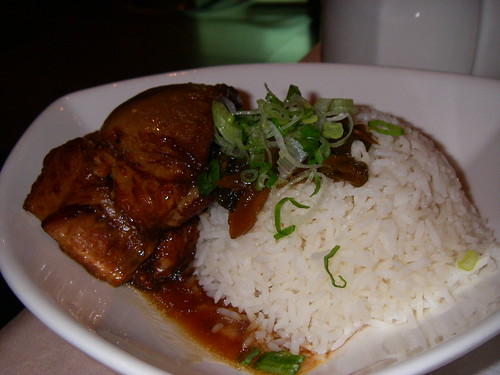
Another surprise were the Szechuan style grey clams garnished with handfuls of dried chillies, Straits-style. Delicious but so searing hot that I could only try a single one. From what my hardened mates said about the spices, these were spot-on.
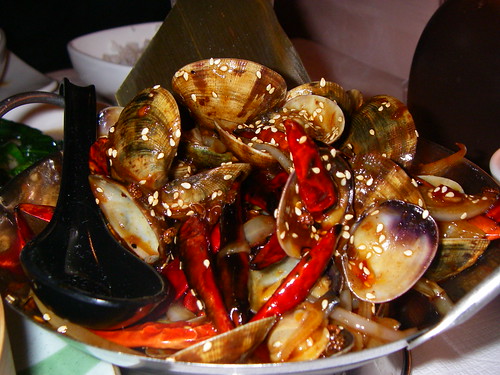
The pig kidney looked at first sight like intestines, which I will have to order next time as there wasn’t any room left. Scored strips of kidney in a delicious broth which, alas, didn’t taste either of sesame oil or rice wine. But then the wine used in Taiwanese cooking is more delicate. I kept sipping the stock as we worked our way through dish after dish. It acted like a digestive: chicken soup for the belly.
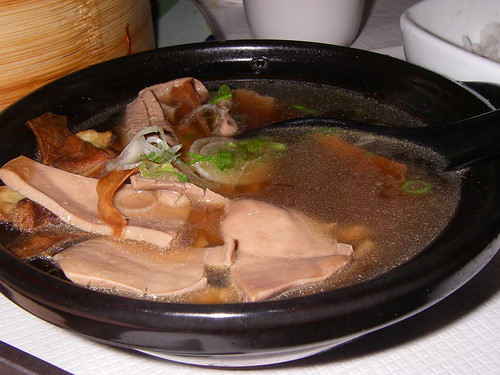
The deep-fried pork chops took me straight back to the campus of Sun Yat-Sen University. This was in definite need of chilli oil.
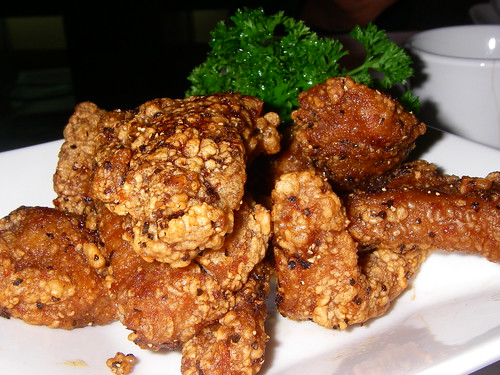
With that (and the pork belly), we entered banquetting territory. I first had beef tendon in one of Kaohsiung’s foremost hotels. And it is good, if it is soft. Not all these pieces were. The sauce was so sweet that the dish was almost candied.
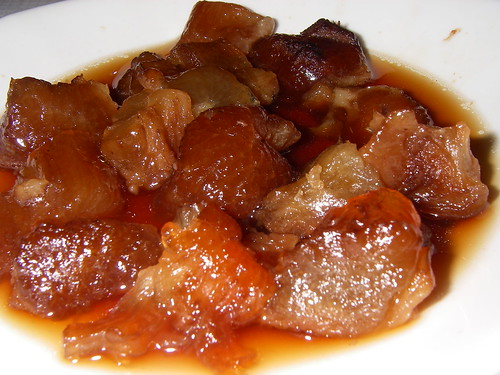
There are tastes which you can recognise, if not describe. Mixed in with the Duck with Chinese Angelica and Herbal Rice Noodle Soup were things that looked like chopped prunes and tasted as if they had been fermented and then smoked for a long time over pinewood. Great stuff.
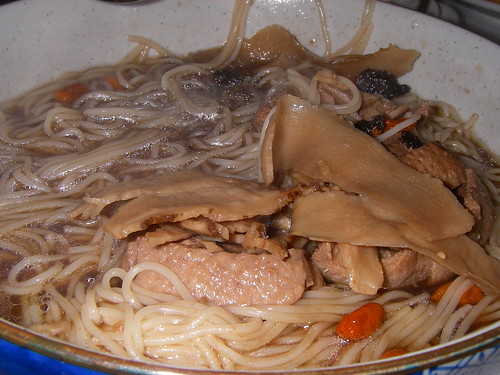
No birthday is complete without a good-luck-dish and during banquets, the fish head is pointed at the honoured guest. Since I was the only one to have fish, I figured that I might as well make it a head of salmon.
Not for the faint-hearted, this dish needs greater skill than mine to tackle with chopsticks. I remember once taking home a fish head for dissection, but it fell apart before I could get a clear idea where everything fitted. Be assured that there are a lot of bones.
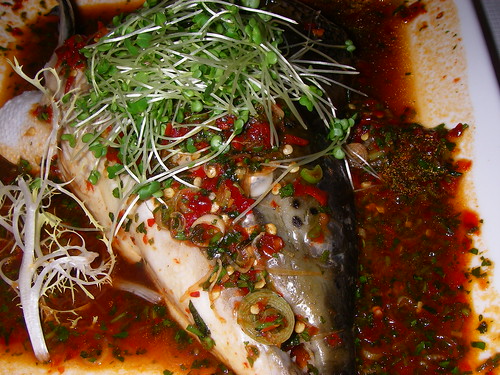
Salmon is a fatty fish, but usually the fat is marbled through the flesh, giving it a silky texture. As with meat, it holds a lot of flavour. Just how much I found out when I prised the flakes of translucent fat from underneath the thick skin on the top of the salmon’s skull. This is one of the unique morsels which sets the head apart from the rest of the fish. It was melt-in-the-mouth delicate, but overwhelmingly fishy.
I fared better with the eye, which was like a burst of fine bullion, although I could have done without the rubber lens and crunchy keratin lining. Like most first-timers (I suspect), I bit on the eye and then swallowed it whole.
“You should have chewed,” John said.
At last I found a little gelatinous mass that might have been the brain. It was good; less in-your-face than the fat.

The fish head will stay off the menu next time, but we’ll be back to sample more than the fraction of the dishes on offer, including some deserts. One thing is for sure: this kind of food is unique and different from standard Chinese cooking, even from the Mandarin and Cantonese under-the-counter menus (although each proper restaurant has its specials and its strengths).
Why is this so?
When the then government fled to Taiwan, they took the imperial treasures with them. Stashed deep underneath a mountain, a selection is displayed at the Imperial Palace Museum in an exhibition which rotates every three months. It takes twelve years to get through them all.
They also took the best chefs, preserving and refining traditions which have been lost on the mainland.
Tags: Food, Soho, Taiwan, Travels on my Doorstep, Tag Index